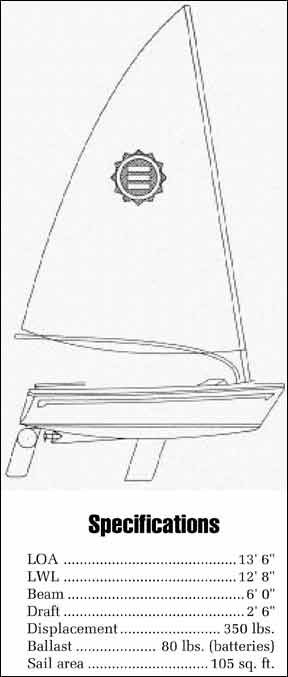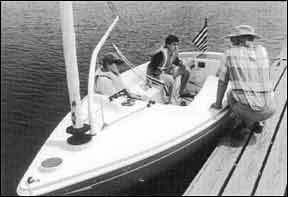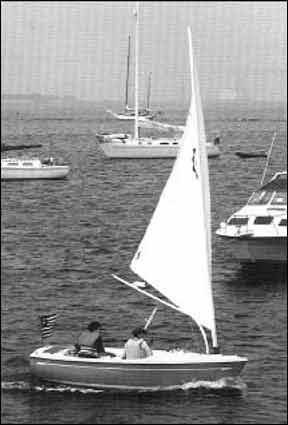Put Gary Hoyt, Ted Hood and Everett Pearson in a canoe and you have the marine industry’s maximum tripartite brain power. The cerebral sparks from these three New England dynamos produced the EXPO Solar Sailer.
Introduced at Sail Expo ’93 in Atlantic City, the EXPO Solar Sailer is a brilliant, purposeful little boat. The object is to “solo” a rank beginner in an hour.

Despite its utility as an educational tool, the 13-1/ 2-foot boat was dubbed by Naval Architect Bob Perry as “an ideal daysailer for a sailor with a relaxed attitude.”
In short, it’s a fun boat-at the other end of the scale from, for instance, a sailboard, which is guaranteed to make anyone look foolish for a couple of weekends.
Design and Construction
The EXPO was conceived by Hoyt (who has a long list of conceptions to his credit), designed by Hood (who needs no introduction) and built by TPI (at present, or one time or another, the builder of J Boats, Aldens, Jeanneau catamarans and Freedoms).
“It takes both the mystery and the fear out of learning to sail,” said Hoyt, who, beginning with the Freedom 40, has spent 20 years trying to take the mystery out of learning to sail. He can talk for hours about how fast, tippy boats intimidate beginners, and that if the sailing industry is serious about attracting newcomers, it must first provide a simple, safe boat that won’t scare off those on the edge of jumping in. That’s the premise of the EXPO Solar Sailer.
Hood calls the EXPO a “cruising Finn dinghy” because the shape of the hull, although beamier, is like the Olympic-class Finn. Pearson is proud of the EXPO’s sturdiness.
The hulls are “Infused Resin Molded” using a vacuum-bagged, injected resin system that creates a powerful, high strength-to-weight composite that should defy decades of hard usage.
She’s a fat little rascal, very stable. Hoyt said that of the 70 built and in use as of late 1994, mostly in educational programs and rental businesses, he knows of only one capsize (by a very hefty gentleman beginner who, in a stiff breeze, jibed and didn’t move until he was in the water).
The white-painted aluminum boom, independent of the rotating mast, arches up and over the cockpit. You’d have to stand up to get clouted. Hoyt has applied for a patent on the free-standing boom.
The 14-pound, tapered carbon fiber mast rotates on a Harken base. The 105-square-foot, loose-footed sail furls on the mast, very easily controlled by a continuous line that serves also as an outhaul. The outhaul and rotating mast also provides reefing, in seconds, with little effort.
On the non-skid deck just forward of the cockpit is a permanently-mounted windvane with color-coded sectors. To trim the sail, the beginner merely matches the color-sector indicated by the vane to the color-coded mainsheet, held in a Harken cam cleat pedestal mounted in the cockpit.
The kick-up rudder is mounted inboard, not only to make it very accessible to the skipper but to give the EXPO a proper yachty look. The daggerboard is easy to operate and has a stopper hole and pin to secure it in the withdrawn position. With the board up and the rudder taking care of itself, the EXPO can simply be winched up on a dock or trailer.
It has a two-way Henderson pump, one channel to pump the hull, the other for the cockpit, which is not self-draining because Hoyt wanted to keep the floor low for adequate leg room. A commodious bow compartment with a well-fitted door provides stowage for a cooler, lunch, foul weather gear and an anchor and rode (in case you want to stop to fish or swim).
The EXPO displaces 350 pounds. It carries up to six persons, but Hoyt conceded that with that load she’d be crowded and sluggish.

To get away from the dock and motor about, it has an electric engine powered by two securely-anchored gelcell batteries (with an in-line regulator and battery meter) charged by a flexible Unisolar solar panel mounted neatly on the deck aft of the cockpit.
There’s also a built-in 110-volt charging unit. The simple engine switch handle provides three forward speeds and two in reverse. The little prop is protected by a skeg. In flat water, the boat will motor at close to 3 knots (full power) for three hours, five hours at half-speed. Hoyt warned that, under power, it will not work against much of a chop.
Aboard the EXPO, you can shove off and be sailing in five minutes. The EXPO has a hull speed of 4.7 knots, which it should reach in a moderate breeze, even while dragging the little prop on the Minnkoto engine.
The Sail Trainer Test
To try out the EXPO, we dragooned two lads—a 14-year-old experienced Laser racer (he happens to be our son, Kyle Nouse), and Kyle’s 14-year-old buddy, Joe Costa, who knew absolutely nothing about sailing. In fact, he never before had been aboard a sailboat of any kind.
At Newport’s Ida Lewis Yacht Club, the day was hot, with a moderate breeze, with some slightly heavy gusts.
We elected to conduct the test as though we had bought the EXPO for use on an inland lake or bay, taken it out of the crate, assembled it, and said, “It’s all yours, boys.”
Our experienced lad looked over the boat for no more than 10 minutes, tried the furling and the engine controls, pushed the daggerboard down, straightened up the mainsheet, cast off and in less than three minutes was sailing back and forth. Our neophyte, Joe Costa, watched carefully from the dock.
As instructed, Kyle furled the sail and motored back to the dock, with little ado. All he said was, “Awesome.” but he says that often.
With Kyle as a passenger (under orders to not provide even a speck of help or advice), Joe Costa stepped aboard, a bit timorously, settled himself in the starboard aft corner of the cockpit and cast off. He motored away from the dock, hooked the boat into the wind, unfurled the sail, checked the color-coded wind vane and sheet and shouted, “Hey, I’m sailing!”
There was one glitch. Because Joe had an overwhelming tendency to jibe to starboard, round and round and round and round, he skinned too close to shore and ran aground. Kyle quickly furled the sail, put the engine in reverse, pulled up the daggerboard (she draws 2′ 6″ with the board down), backed into deeper water and had Joe sailing again in two or three minutes.

After coming into the dock to collect Joe’s wits and add a little advice about going to weather and the need to shift his butt to the windward side, off the boys went again, this time for a half-hour sail, during which Kyle quickly refined Joe’s skill at tacking, jibing and, most of all, going straight.
Kyle said the most difficult part for Joe was going to weather, keeping the boat moving in a straight line, and then tacking.
It all took about an hour and a half, at the end of which Kyle and Joe were zipping around the harbor, changing helmsmen frequently. When hailed, they responded:
“Do we have to come in now?”
When they did, they were making plans to go out in a Laser, at which time Joe’s learning curve will take a steep upward turn.
Conclusion
What do we think of the EXPO?
It’s a marvelous design, beautifully built with a great rig. With a sail area/displacement ratio of 37 and a displacement/length ratio of 76, it moves very well in most any kind of air. Reefed down a bit, it can handle some fairly heavy going.
However, as a dinghy, the EXPO wouldn’t do. It’s too heavy to tow or lift aboard. It might make a tender or harbor sailor for a big boat that can hoist her aboard, but unshipping the mast would be difficult.
As a teaching tool for both youngsters and adults, this little boat is peerless, squarely meeting its designed intent better than any boat we’ve ever seen. For both commercial usage and for junior programs at yacht clubs and sailing associations, it’s ideal.
We also see the EXPO as simply a very safe, comfortable, inland lake or bay boat that would be a joy to own.
The 1994 price, $6,415, which includes everything, reflects the high quality present in every detail. The price is difficult to compare with other daysailers. Lined up against engineless boats like a Laser ($3,200) or a Sunfish ($2,200), she’s expensive.
However, compared with a 15’ West Wight Potter at $5,995, a Peep Hen 14 with a 4-hp. outboard at $7,245, or an American 14.6 (a Carolina version with an outboard and trailer) at $4,250, the EXPO seems reasonably priced.







































